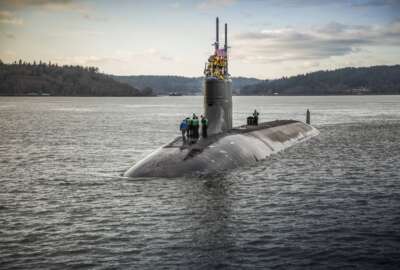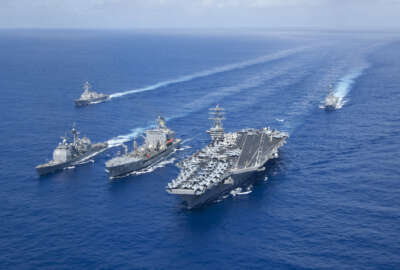
Not everything in the ocean is natural. A look inside the Navy’s mine warfare center.
In Federal Drive host Tom Temin's final interview of this week's series on naval oceanography, he talks with the Mine Warfare Center's commanding officer, Comma...
Best listening experience is on Chrome, Firefox or Safari. Subscribe to Federal Drive’s daily audio interviews on Apple Podcasts or PodcastOne.
The Navy’s oceanography activities go wide and deep. They also include tracking and if necessary neutralizing things in the ocean that didn’t get there naturally, like explosive mines for example. That’s where the Naval Oceanography Mine Warfare Center comes in. In our final interview of this week’s series on naval oceanography, the Mine Warfare Center’s Commanding Officer Commander Matthew Watts joined the Federal Drive with Tom Temin.
Interview transcript:
Tom Temin And tell us exactly, at the beginning here, what the Oceanography Mine Warfare Center actually does, and where do you do it from?
Matthew Watts Sure thing. So my command primarily supports the Navy’s mine warfare mission area. Specifically, we provide embedded tactical oceanography support for mine countermeasure forces globally. We do that down in Stennis Space Center in Mississippi. And we deploy small teams throughout the world, leaving from Stennis Space Center, to carry out unmanned undersea vehicle (UUV) ocean bottom surveys, and the post mission analysis that goes along with collecting side-scan sonar data. We use the Mk 18 Mod 1 program of record system for the Navy, which is just a fancy word to say a small man portable UUV. So two personnel can pick up the UUV and toss it in the water and do some ocean surveys. Number two, we also provide environmental data analysis, as well as mine context fusion and change detection, for mine warfare operational commanders. And this includes air, surface and unmanned mine countermeasure forces, or MCM, forces.
Tom Temin Well, let me ask you this question about mines, because people sow waters with them. In the case of landmines, they stay there forever. And there’s a whole unit of the federal government centered on the State Department whose mission it is to try to help countries relieve themselves of landmines. That’s going to be a big issue in Ukraine eventually. In the ocean, are mines something that are dropped in, and they’re there forever until someone takes care of them?
Matthew Watts Yeah, that is one method of deploying naval mines is basically just dumping them in the ocean and whether they’re moored mine, which means they have a anchor at the bottom and they extend into the water column a mines. We’ve used those for many, many years. There’s also moored mines or mines that are actually on the ocean bottom and they are triggered when a ship or something of interest crosses the path of that mine and explodes. And then there’s also floating mines, which are basically one of the worst case scenarios similar to land mines, right, something that’s just there, and it’s a floating mine. It’s able to drift with ocean currents and quite a bit of havoc, not that the others don’t cause havoc, but just it’s a floating mine, a lot less control by the blue force or the red force that employed those mines.
Tom Temin And is the center that you command concerned with helping the Navy mine waters or is it also concerned with helping the Navy remove mines or detect mines and help mitigate them that have been laid by others are all of the above?
Matthew Watts The Naval Oceanography Mine Warfare Center primarily focuses on the defensive aspect of mine countermeasures. So if there’s a minefield laid, we want to clear that minefield or look for alternative routes around a minefield. But we do have capability to understand the ocean environment of which you would place a mine. So we have capability to do such thing as required.
Tom Temin And so understanding the oceanography that is conducive to mines, I imagine could help predict where they might be in the first place.
Matthew Watts That is correct, whether it’s just the ocean currents acoustic environment that you’re operating in, but also just the water depth itself. Certain mines are only able to be employed in certain regions of the ocean. So knowing that information will also help limit or improve our understanding and tactical advantage to support the warfighter.
Tom Temin We’re speaking with Commander Matthew Watts of the Naval Oceanography Mine Warfare Center. And how prevalent is this in the world right now, I mean, is the Navy actively finding and trying to neutralize other nations minds in public waters? Give us an example of how this might happen in reality.
Matthew Watts If you’re in a harbor or have a small region, even just a small fishing port, if you will — that’s not as much of a concern for us but just take that as an example — if an enemy was to lay mines across the opening, or the port of demarcation of a certain region, that would limit your ability to leave. And then usually really, it doesn’t take a whole lot. It’s an inexpensive tool for an enemy force. A single mine in an area of the ocean, which we’re not familiar with does give commercial traffic as well as military units pause before they go and plow away through the oceans. It’s definitely a tool that can be used by enemy forces. And we practice with ourselves internally to the Navy, but also with a lot of partner nations as we continue to prepare for potential operations forward.
Tom Temin And are there still minds leftover from very old conflict, say World War II, or I don’t know if there was much mining in the Vietnam era and so on, or other wars, foreign wars that didn’t involve the United States? Do you still find old mines where people thought it was all over with?
Matthew Watts Yeah, there are areas that are still basically active mine areas. You mentioned the World War, definitely from World War II. A lot of mines were used back then and still prevalent in certain areas and we’re concerned of any potential those and breaking away and causing problems.
Tom Temin And these are a danger that not just to naval ships, but to anything in the water.
Matthew Watts That is correct. Whether it’s on the surface or whether it’s through the water column, so impacts to all types of vessels.
Tom Temin Right, so the mine could be suspended below the surface and not just floating as we normally think of them.
Matthew Watts Exactly. Those mines can be contact mines, where a vessel has to actually bump into the mine before it is triggered and explodes. But there’s also influence mines, which are continually [either] listening for an acoustic signal or if they’re a pressure sensor, like a certain size vessel has to pass over the mine before it actuates.
Tom Temin And how has naval practice and doctrine changed? You mentioned use of an underwater unmanned vehicle now to look at the waters and measure the waters and try to detect these things. You hear old time stories about mine sweeping and chains between boats and this kind of thing, is at all pretty much in the past now?
Matthew Watts We still have some legacy capability to do the mine sweeping and so on. But we’re really more focused on mine hunting, which is a little bit more deliberate. So we prefer for mine hunting is to use unmanned underwater vehicles, if at all possible to do surveys of the ocean bottom, and we collect that data, we analyze it, we look for manmade objects, but also really mine-like contacts. And if we find a mine-like contact through side-scan sonar imagery, we are able to send another vehicle forward to reacquire, to identify that as a potential mine. And if we find out that it’s a mind, we go ahead and have either divers or a remote operated vehicle to place charge on that mine that we found and neutralize that at that point. And that’s not up our alley. But we’re the science behind getting that last point.
Tom Temin And where in the world do you operate? There’s a lot of waterfront on the Earth that the Navy could potentially come close to or certainly the rest of the world is worried about it.
Matthew Watts Yeah, very true. So I mentioned that we’re a global force, we leave from Stennis Space Center. But I also have four small components that are embedded with the local operational mine warfare commanders. Those were aligned with the different fleets for our Navy. So third fleet in San Diego, fifth fleet in Bahrain, as well as sixth fleet we have Rota, Spain and lastly seventh fleet we have Yokosuka, Japan. So I have personnel forward. Not only do they provide the meteorology and oceanography for day to day operations, but they also coordinate annual exercise participation for my command, as well as they’re prepared for contingency operations and make sure that we’re on scene as quick as we can get there.
Tom Temin And just give us a sense of the size of your command. How many people work there? Is it mostly uniform? Do you have also civilian employees and contractors?
Matthew Watts We’re modest commands really, about 80 personnel. And that includes the small components that I have out forward. That includes officer and enlisted and I also have a couple contractors that give us some great support for the Mk 18 Mod 1 vehicle, help us to not only operate the vehicle but continue to advance our training and our tactics and procedures.
Tom Temin And how often do you find mines that you might have been unaware of? And how often do they get blown up harmlessly?
Matthew Watts That’s an interesting question. I will say that for the most part, we’re not bumping into many mines. More so we’re looking for mine-like shapes that have been placed during either operations or working with our other partner nations to prepare the force for action.
Tom Temin Any evidence like North Korea does mine operations or Russia or countries like that?
Matthew Watts We sure believe they do.
Tom Temin Commander Matthew Watts is commanding officer of the Naval Oceanography Mine Warfare Center. Thanks so much for joining me.
Matthew Watts That was great to be here and I appreciate the time.
Copyright © 2024 Federal News Network. All rights reserved. This website is not intended for users located within the European Economic Area.
Tom Temin is host of the Federal Drive and has been providing insight on federal technology and management issues for more than 30 years.
Follow @tteminWFED





